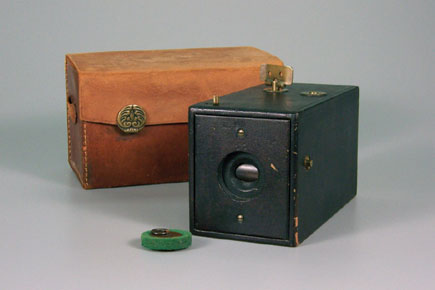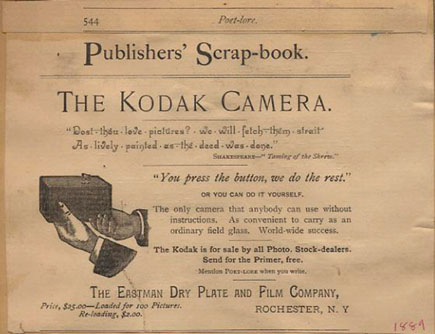Classic Cameras; The Final Countdown; The Top 20 Cameras Of All Time Page 2
2) Kodak Brownie--1900
 |
If any single camera can claim to have created the snapshot, that common,
unpretentious memento of things as they are, it is the immortal Kodak Brownie
box camera introduced to the world at the turn of the last century in February,
1900. It was neither the first box camera, nor the first camera to use paper-backed
roll film with numbers on the back (that was the 1892 Bull's-Eye Camera
made by the Boston Camera Company, later acquired by Kodak). However, by offering
a simple, competent, easy-to-use, daylight-loadable camera at the then-unprecedented
price of $1, and putting a brilliantly conceived mass-marketing program behind
it, Kodak was literally able to sell a camera to practically everybody, and
to motivate millions to buy it. The Brownie's success was unprecedented--in
the first year alone, over 150,000 cameras were shipped, three times the previous
record. To get a clearer idea of the impact of the Brownie, check out one of
the many timelines of the 20th century and go to the year 1900. Right up there
along with such momentous events as Max Planck's formulation of the quantum
theory and the publication of Sigmund Freud's The Interpretation of Dreams
is Kodak's introduction of the $1 Brownie camera!
The Brownie got its name from artist Palmer Cox's whimsical cartoon versions
of Brownies--"hard-working Scottish sprites or elves who did household
chores"--that were as popular in the 1880-1920 period as Mickey Mouse
is today. Some have conjectured that the name was an oblique tribute to Frank
A. Brownell, who was responsible for its design and manufacture, but this is
not the case. In any event, the Brownie is about as simple and basic as a camera
can get--an imitation leather-covered cardboard box, with wooden film carrier,
measuring about 3x3x5". It has a simple fixed-focus f/11 meniscus lens,
and metal rotary shutter with a single speed of about 1/35-1/50 sec plus T.
There isn't even a viewfinder--like the original Kodak of 1888.
 |
Despite its modest specs, the original Kodak Brownie did score one extremely
important historical distinction--it pioneered No. 117 film, thus making
it the world's first 21/4x21/4" rollfilm camera. The 117 size, essentially
six exposures of 120 film on a narrower flanged roll, is long defunct, but the
glorious 21/4 square rollfilm format is still very much alive.
Ads stressed it could be "operated by any schoolboy or girl" and
kids were urged to join the Brownie Camera Club, which had no initiation fee,
and whose object was "to increase the interest of American boys and girls
in matters pertaining to photography." Kodak ran picture contests and
awarded prizes. A roll of film, called a "Transparent-Film Cartridge,"
six exposures of 21/4x21/4" cost 15 cents, a box of paper, 10 cents, and
a Brownie Developing and Printing Outfit, 75 cents. At the bottom of many ads
was a small box with the message, "Send a dollar to your local Kodak Dealer
for a Brownie Camera. If there is no dealer in your area, send us a dollar and
we will ship the camera promptly." With the arrival of the Brownie, anyone
could take photographs of everything from special occasions to everyday life,
and do so inexpensively. The era of the snapshot had dawned and the world would
never be the same.
Today, an original Brownie camera with "shoebox" back cover and
accessory viewfinder is a rare bird indeed and a collector's prize valued
at about $2000. The later, improved version with hinged back, also a primo collectible,
sells for about $300-$500 with original winding key and box. The long-running
#2 Brownie (1901-'33), that took 120 film and had a 21/4x31/4 format,
is a nice user-collectible that sells for $35-$50 and is recommended to anyone
who wants to experience shooting with a classic box camera.
1) The Kodak--1888
 |
The Kodak, the first camera marketed by The Eastman Dry Plate and Film Company
of Rochester, New York, is, in the opinion of many experts, the most historically
important series-production camera ever made. The only cameras that rival it
in historical significance are the one-off or limited-production creations of
photography's great pioneers, Niepce, Daguerre, and Fox Talbot. What makes
this humble-looking box camera so pivotal and consequential is not its ingenious
construction or technical brilliance, both of which are noteworthy, but the
idea it embodied--creating a camera capable of producing satisfying photographs
in the hands of an ordinary person having no particular technical skill.
When the Kodak was announced in 1888, photography had progressed from the daguerreotype
and wet plate days when photographers literally had to prepare their own plates,
but it was still an arcane pursuit requiring considerable expertise and dedication,
particularly in the darkroom. What the Kodak offered, for the then-handsome
sum of $25, was an unintimidating, easy-to-use, portable camera with no adjustments
that was pre-loaded with roll film sufficient for 100 exposures. When you were
finished shooting the roll, you shipped the camera back to Eastman in Rochester,
along with $10. They developed the film, transferred each negative to a sheet
of glass for contact printing (because the 23/4"-wide "stripping
film" was mounted on a non-transparent paper backing), made one print
from each good negative, reloaded the camera with film for 100 more exposures,
and returned it to the owner. In the context of the 19th century, the Kodak
was the world's first successful point-and-shoot camera, but it does not
qualify as the first one-time-use camera because you got your original camera
back. More importantly, it was the camera that really created the modern photofinishing
industry.
 |
The man behind the Kodak camera was of course George Eastman, a man of considerable
mechanical ability and one of the great conceptual and marketing geniuses of
all time. The actual patent for the Kodak (Patent #388,850, September 4, 1888)
bears his name, but it incorporates several ideas used in Eastman's Detective
Camera of '86 that was designed by Eastman and Franklin M. Cossitt, an
employee. Another significant predecessor of the Kodak that provided vital elements
of its design was the Eastman-Walker roll holder of '85, one of the first
rollfilm backs that may have been inspired by Leon Warnerke's earlier
roller-slide holder, which also used stripping film. The Kodak, manufactured
for The Eastman Dry Plate and Film Company by George Brownell of Rochester,
New York (who may also have had a hand in its production engineering), is a
wooden-bodied box camera clad in Turkey morocco with "nickel and brass
trimmings and enclosed in a neat sole leather case with shoulder strap."
Described as "about the size of a large field glass," it measures
31/4x31/4x61/2" and weighs 1 lb, 10 oz. It produced circular pictures
21/2" in diameter on 23/4"-wide flexible roll film, had no frame
counter (you had to count the number of turns when winding the film-advance
key!) and no viewfinder--you aimed it with the aid of two lines, in a V
pattern, engraved into the top. The lens, contained in a unique barrel-type
shutter that revolved on an axis parallel to the film plane, was a 57mm f/9
Rapid Rectilinear. Based on the format it was a wide angle, which gave good
depth of field, but image quality in the corners of the field would have been
poor, so the cornerless circular format made sense technically. The shutter,
which was manually cocked with a pull cord, provided a single shutter speed
of about 1/25 sec, but a felt plug, which fitted on the front of the camera,
could be used for making timed exposures. The shutter release button was on
the left, a tripod socket oddly placed on the top--but with no viewfinder
this hardly mattered!
Despite its Spartan simplicity, ample price, and the inconvenience of having
to return the camera for processing, the Kodak was a phenomenal success because
it was the first camera that enabled anyone to take pictures, and it was aggressively
marketed with a brilliant advertising campaign. Eastman's astute grasp
of human psychology and motivation is evident in these quotes from an '88
Kodak ad, "Anybody who can wind a watch can use the Kodak Camera...No
tripod, no focusing, no adjustment whatever..."
In '89, it was: "1) Pull the cord. 2) Turn the key. 3) Press the
button. And so on for 100 pictures." This was later refined into the greatest
photographic advertising slogan of all time, "You press the button, we
do the rest." Those too impatient to send their cameras to Rochester could
buy darkroom-loadable 100-exposure film spools for $2 apiece, and develop and
print their own film, or send the exposed film back to Rochester and have it
processed and returned with a fresh roll for $10. More than any other single
camera, the Kodak helped to create the modern photographic industry by transforming
the act of taking pictures into a universal human experience.
An original Kodak Camera, one of the Holy Grails of camera collecting, now verges
on being a museum piece. Early barrel-shutter models in good condition sell
in the $4000-$5000 range, though a really pristine and complete example with
case and instruction manual could easily fetch much more. Later models with
a "safety-pin" metal-bladed shutter are worth less, but are still
scarce and collectible.
The Top 20 Cameras Of All-Time |
|
| 1) The Kodak--1888 | 11) Rolleiflex (Original Model)--1929 |
| 2) Kodak Brownie--1900 | 12) Hasselblad 1600F--1948 |
| 3) Leica A--1925 | 13) Contax S--1949 |
| 4) Kine Exakta I--1936 | 14) Sony Mavica--1981 |
| 5) Leica D (Or II)--1932 | 15) Asahiflex IIB--1954 |
| 6) Polaroid 95--1948 | 16) Zeiss Contax II - 1936 |
| 7) Kodak Super Six-20--1938 | 17) Rolleiflex Automat - 1936 |
| 8) Minolta Maxxum 7000--1985 | 18) Hansa Canon - 1935 |
| 9) Konica C35AF--1979 | 19) Reflex-Korelle - 1935 |
| 10) Leica M3--1954 | 20) Kodak Instamatic 100 - 1963 |
What would you have added to or
subtracted from Jason's Top 20 list? Share your opinions, and your favorites
on the Top 20 Cameras Forum at www.shutterbug.com |
|
- Log in or register to post comments

































